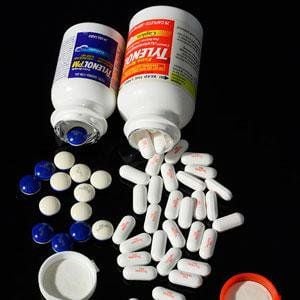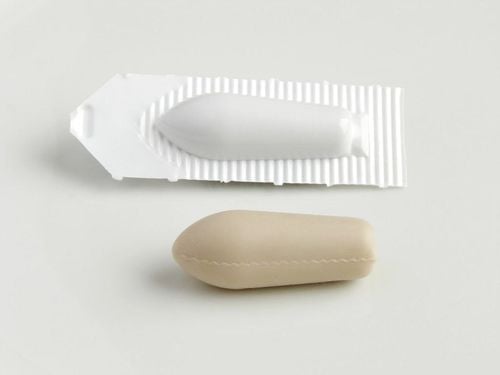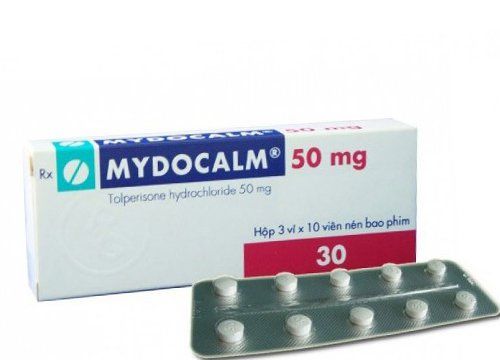Thiocolchicoside is a muscle relaxant widely used for managing painful muscle spasms. With additional anti-inflammatory and analgesic properties, thiocolchicoside is often prescribed for patients suffering from chronic back pain, orthopedic disorders, and rheumatic conditions.
1. What is Thiocolchicoside?
Thiocolchicoside is a semi-synthetic derivative of colchicine, a natural anti-inflammatory glycoside extracted from the gloriosa lily (Gloriosa superba). It acts as a muscle relaxant with anti-inflammatory and analgesic effects. However, the medication is contraindicated in individuals with an extensive history of seizures.
Mechanism of Action
Thiocolchicoside binds selectively to GABA-A receptors, promoting muscle relaxation by activating inhibitory GABAergic pathways. In other words, Thiocolochicoside competitively antagonizes GABA and glycine receptors, with activity resembling that on nicotinic acetylcholine receptors.
As such, this drug is frequently combined with glafenine and meprobamate to sedate patients during diagnostic procedures that require compliance such as CT scans or ultrasounds.
In the treatment of painful muscle spasms, Thiocolchicoside alleviates muscle stiffness caused by central nervous system disorders and reflexive contractions. It is also effective for managing rheumatic conditions and physical traumas. Furthermore, Thiocolchicoside helps reduce symptoms associated with post-stroke hemiplegia, Parkinson's disease, and notably, neurological disorder syndromes. Other conditions where Thiocolchicoside may be effective include: acute and chronic lower back pain, sciatica, servico-brachial neuralgia, persistent torticollis, post-traumatic or post-surgical pain.

2. Therapeutic Uses of Thiocolchicoside?
With numerous therapeutic effects on the body’s nervous system, Thiocolchicoside is often used to alleviate pain caused by various musculoskeletal and neurological conditions, including:
- Acute and chronic back pain
- Postoperative pain
- Muscle spasms
- Ankylosing spondylitis
- Rheumatoid arthritis
- Arthropathies
- Vertebral injuries
- Trauma-induced injuries
- Neuritis
- Persistent muscle spasms
Similarly to other drugs with anti-inflammatory and analgesic properties, Thiocolchicoside can inhibit cyclooxygenase, enhancing its analgesic effect.
3. Instruction for use of Thiocolchicoside.
Thiocolchicoside capsules should be taken during or after meals to avoid any gastrointestinal irritations. If thiocolchicoside is to be administered via parenteral routes, it should be done under a physician’s prescription and supervision in a hospital setting.
The dosage of thiocolchicoside shall be adjusted based on the patient’s health status and the disease progression. As such, it is advised that patients should not take an altered amount from the prescribed dosage, or stop the medication regimen altogether, as this may exacerbate symptoms. Please consult your physician if you suspect of overdosing.
Lastly, patients should provide their medical history and list any current medication uses, prior to receiving the prescription. Thiocolchicoside use is only recommended for adults or adolescents above 16.
4. Therapeutic Effects of Thiocolchicoside?
Thiocolchicoside is a prescription-only drug, as dosage and potential side effects may differ between individuals.
Common side effects of Thiocolchicoside may include drowsiness, abdominal pain, bloating, nausea and diarrhea. More importantly, you should immediately notify your healthcare provider for any of the following symptoms:Itching or rashes, dry mouth, jaundice, sudden hypotension,and rapid heart rate
Thiocolchicoside is contraindicated in individuals with severe kidney disease, a history of seizures, asthma, or acute rhinitis. It should also be avoided during pregnancy and breastfeeding.

5. Precautions When Using Thiocolchicoside
Information for Patients
Thiocolchicoside is often used to treat painful muscle spasms or other related symptoms. However, recent studies have shown that thiocolchicoside is metabolized into M2. This compound, with sufficient amounts, may potentially be harmful to genetic material, leading to chromosomal and cellular division abnormalities, reducing male fertility, and inducing fetal harm during pregnancy.
While long-term use of thiocolchicoside theoretically poses a risk of developing cancer, no concrete evidence currently supports this. To minimize the production of M2 and reduce associated risks, thiocolchicoside-containing drugs are recommended only for short-term therapy as an adjunct therapy for muscle spasms, particularly spasms in regions around the spine of adults and adolescents aged 16 and above.
Thiocolchicoside should never be used during pregnancy or breastfeeding. Women of childbearing potential must employ highly effective contraception during treatment. Topical formulations of thiocolchicoside, which generate significantly lower M2 levels, do not affect cellular genetic material and may be safer for localized use.
Information for Physicians
Systemic thiocolchicoside is recommended only as an adjunct therapy for acute muscle spasticity related to spinal disorders in adults and adolescents aged 16 years and above. It is not advised for the long-term management of chronic pain.
For oral thiocolchicoside, the maximum recommended dose is 8 mg every 12 hours, with a treatment duration of no more than 7 consecutive days. For intramuscular administration, the maximum recommended dose is 4 mg every 12 hours, for a maximum of 5 consecutive days.
Patients receiving systemic thiocolchicoside should be closely monitored during follow-up appointments, and alternative therapies should be considered as appropriate.
In summary, thiocolchicoside is used for muscle relaxation and pain relief in conditions involving skeletal muscle spasms. Its mechanism involves acting on the central nervous system in the brain and spinal cord to alleviate stiffness and spasms. Use of thiocolchicoside should always be guided by a healthcare professional, with any unusual symptoms reported promptly and ongoing responsiveness to treatment carefully evaluated.
Please dial HOTLINE for more information or register for an appointment HERE. Download MyVinmec app to make appointments faster and to manage your bookings easily.
References: medicoverhospitals.in, ema.europa.eu, go.drugbank.com, practo.com
To arrange an appointment, please call HOTLINE or make your reservation directly HERE. You may also download the MyVinmec app to schedule appointments faster and manage your reservations more conveniently.








